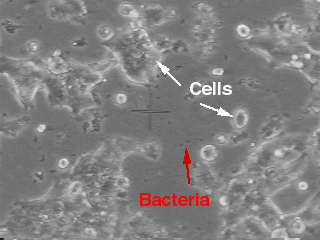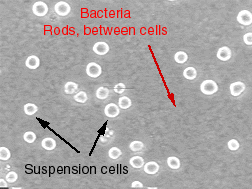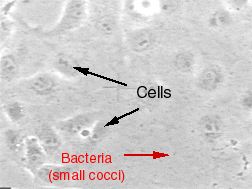Bacteria

Bacteria (cocci) @ 320x magnification. In this example, the cells are the larger refractile bodies, while the bacteria appear as very small dark “dots” in the spaces between the cells.

Bacteria (rods) @ high conc. between cells

Bacteria (cocci) between cells
Typical routes of infection in cultures: Possible sources of contamination are innumerable, but the most likely source of bacterial contamination in the cell culture working environment is the water bath. We recommend that the water bath be emptied and cleaned every month. We recommend that the bath be filled with sterile ddH2O and 0.05% benzalconium chloride to inhibit microbial growth. Also, the humid environment of the CO2 incubator provides ideal growth conditions for many strains of bacteria. We recommend that the incubator be cleaned out once a month with a chemical disinfectant such as 70% ethanol and/or 1% benzalconium chloride. Also, it is beneficial to autoclave shelves and water pans. Water for humidification should be as recommended above for water baths. Other routes of infection to be aware of include: contact with non-sterile surfaces when performing cell culture manipulations, spillage on materials and the work surface, splash-back from pipetting or pouring cell suspensions and reagents, microscopic aerosols and infestation by insects, mites or dust into supplies.
Antibiotics: The most commonly used antibiotics in cell culture are penicillin/streptomycin (pen/strep), gentamicin, kanamycin, and ampicillin. All four are effective against both gram-positive and gram-negative bacteria (pen/strep only when used together). Gentamicin and kanamycin are also marginally effective against some strains of mycoplasma. Typically, pen/strep are used together and gentamicin and kanamycin can be used together. Avoid using cocktails of many antibiotics because all are, to some extent, slightly toxic in media and too many used together can result in a cumulative toxic effect on cells. A very useful list of antibiotics, the organisms they are effective against, and recommended working concentrations compiled by the Sigma-Aldrich Company can be found as a pdf document (129Kb, 3 pages).
